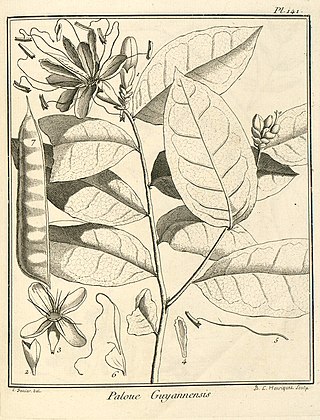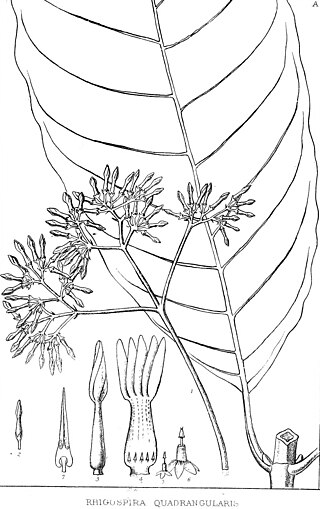
Amanoa is a genus from the family Phyllanthaceae first described as a genus in 1775. It is native to South America, Central America, the West Indies, and tropical Africa.

Couroupita is a genus of flowering plants in the family Lecythidaceae first described as a genus in 1775. It is native to tropical South America and Central America.
- Couroupita guianensis - Cannonball tree -Guyana, Colombia, Ecuador east to Amapá and south to Bolivia; naturalized in the West Indies as well as in Bangladesh, Sri Lanka and Andaman & Nicobar
- Couroupita nicaraguarensis – Bala de cañón, coco de mono, paraíso, zapote de mico, or zapote de mono -Nicaragua, Costa Rica, Honduras, Panama
- Couroupita subsessilis - northern Brazil, northern Peru
Conceveiba is a plant genus of the family Euphorbiaceae, first described as a genus in 1775. It is native to South America and Central America.
- Conceveiba guianensisAubl. - Brazil, Peru, Bolivia, Ecuador, Colombia, Venezuela, 3 Guianas
- Conceveiba hostmaniiBenth. - Guyana, Suriname, Amazonas State in Brazil
- Conceveiba krukoffiiSteyerm. - Venezuela, French Guiana, NW Brazil
- Conceveiba latifoliaBenth. - Colombia, Venezuela, Peru, Amazonas State in Brazil
- Conceveiba martianaBaill. - Venezuela, French Guiana, NW Brazil, Colombia, Ecuador, Peru, Bolivia
- Conceveiba maynasensisSecco - Loreto in Peru
- Conceveiba parvifoliaMcPherson - Panama, NW Colombia
- Conceveiba pleiostemonaDonn.Sm. - Costa Rica, Nicaragua, Colombia, Venezuela
- Conceveiba praealta(Croizat) Punt ex J.Murillo - NW Brazil
- Conceveiba ptariana(Steyerm.) Jabl. - S Venezuela
- Conceveiba rhytidocarpaMüll.Arg. - Colombia, Ecuador, Peru
- Conceveiba santanderensisJ.Murillo - NW Colombia
- Conceveiba terminalis(Baill.) Müll.Arg. - Venezuela, Guyana, Suriname, NW Brazil, Colombia, Peru
- Conceveiba tristigmataJ.Murillo - Colombia, Venezuela, NW Brazil
Micrandra is a plant genus of the family Euphorbiaceae first described in 1854. It is native to South America.

Maprounea is a plant genus of the family Euphorbiaceae first named as a genus in 1775. It is native to tropical Africa, Trinidad, and tropical Central and South America.
- Maprounea africana - W + C + S Africa, from Benin to Zimbabwe
- Maprounea amazonica - Colombia, Venezuela, N Brazil
- Maprounea brasiliensis - Brazil, Paraguay, Bolivia
- Maprounea guianensis - Trinidad, Panama, Colombia, Venezuela, French Guiana, Suriname, Guyana, Brazil, Peru, Ecuador, Bolivia, Paraguay
- Maprounea membranacea - Nigeria, Cameroon, Gabon, Equatorial Guinea, Cabinda, Central African Republic, Congo, Zaire

Couratari is a genus of trees in the family Lecythidaceae, first described as a genus in 1775. They are native to tropical South America and Central America.

Acioa is a genus of plants in the family Chrysobalanaceae described as a genus in 1775. It is native to northeastern South America.
- Acioa barteri -
- Acioa edulis - Amazonas in Brazil
- Acioa guyanensis - French Guiana, N Brazil
- Acioa schultesii - SE Colombia, S Venezuela, NW Brazil
- Acioa somnolens - French Guiana, N Brazil
Forsteronia is a genus of plants in the family Apocynaceae, first described as a genus in 1818. It is native to South America, Central America, Mexico, and the West Indies.
Malouetia is a genus of plants in the family Apocynaceae, first described as a genus in 1844. It is native to Africa, South America, Central America, and the West Indies.

Paloue is a genus of flowering plants in the family Fabaceae. It belongs to the subfamily Detarioideae. The genera was first created with the description of Paloue guianensis by Aublet in 1775.

Amaioua is a genus of flowering plants in the family Rubiaceae. It was first described by Jean Baptiste Aublet in 1775. The genus is native to tropical America from southern Mexico to Brazil, including Cuba and Trinidad.

Couma is a genus of flowering plants in the family Apocynaceae first described as a genus in 1775. It is native to South America and Central America.

Macoubea is a genus of plant in the family Apocynaceae first described as a genus in 1775. It is native to South America and Central America.

Rhigospira is a genus of flowering plants in the family Apocynaceae, first described as a genus in 1878 by John Miers. The species, Rhigospira quadrangularis was first described as Ambelania quadrangularis by Johannes Müller Argoviensis in 1860 but was transferred to the genus, Rhigospira, in 1878 by John Miers. The genus contains only one known species, Rhigospira quadrangularis, native to northwestern South America.

Rapatea is a group of plants in the family Rapateaceae described as a genus in 1775.
Hevea guianensis is a species of rubber tree in the genus Hevea, belonging to the family Euphorbiaceae. It is native to the rainforests of Ecuador, Venezuela, the Guyanas, Brazil, Colombia and Peru. It generally grows on well-drained soils or on those that are only lightly inundated, on river banks, in gallery forests, savannah forests and wooded slopes.
Hevea benthamiana is a species of rubber tree in the genus Hevea, belonging to the family Euphorbiaceae. A medium-sized deciduous tree growing to a height of about 27 m (90 ft), it is native to the rainforests of northern Brazil, Colombia and Venezuela.
Hevea microphylla is a species of rubber tree in the genus Hevea, belonging to the family Euphorbiaceae. It is native to the Amazon basin where it occurs in Venezuela, Colombia and northern Brazil. It was first described in 1905 by the German botanist Ernst Heinrich Georg Ule. It is the only member of the genus to be included in the subgenus Microphyllae.

Tibouchina aspera is a species of flowering plant in the family Melastomataceae, native to Central America and tropical South America. It was first described by Jean Fusée Aublet in 1775. In the original description of the species, it was suggested that the plant was inhaled to treat chest pain and dry coughs.













